Guitar Pedal Order – Part of the Absolute One Stop Guide
As part of the Six String Sensei Absolute One Stop Guide to the Guitar Pedal Board we take an in-depth look into the correct order for guitar effects pedals.
In our last feature on the guitar pedal board it was mentioned that we had left out 2 important aspects of setting up a board, these were:
- Effects pedal order
- True bypass vs. buffered pedals
Well, let’s get into the topic of pedal order. It doesn’t matter whether you set up your pedals on a board or on the floor, pedal order is still very important. Like many other web and magazine articles on this subject, let’s begin with a disclaimer: There is really no RIGHT way of doing things. You can get as creative in the pedal order as you want. But, there are general rules and guidelines to go by that will yield good results because they have been proven to be effective.
For starters, let’s divide the vast array of guitar pedals into 4 different groups based on their job:
- Dynamic pedals
- Distortion and overdrive pedals
- Modulation pedals
- Time based effects
Now, let’s simply spoil the fun and give you the guidelines right away. Generally, you want this order:
- Wahs, compressors and filters first (dynamic)
- Distortion and overdrive next
- Chorus, flanger and phaser effects near the end
- Delay, tremolo and reverb pedal at the tail end
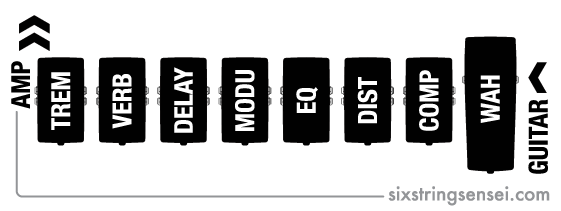
Now that I have told you what the general consensus on proper guitar pedal order is, let’s look into more detail as to why.
Dynamic pedals first in line
Near the beginning we said wahs, compressors and filters. While there are arguments as to which of those actually goes first, let me tell you that for the most part, it’s up to you. It really depends on what sound you are looking for. As an example, while many people prefer the wah first in the chain, I actually like to put a buffer pedal and a compressor before it. I find my Strat to be overly bright when combined with my Fulltone Clyde Wah. I find that having the compressor right before the wah helps to control that brightness quite a bit. Additionally, while this article recommends you put the wah before the distortion pedals, many guitarists prefer to set those up the other way around. Another reason why I want to make sure you understand these are all guidelines not written in stone.
The most obvious dynamic pedal is a compressor. While wahs and envelope filters are a little different and in fact are filters rather than dynamic pedals it’s still safe to bundle them up in this first “dynamic” category. They are generally OK no matter their order as long as they are at the beginning of the chain. At this point it really all depends on which actual models of these pedals you actually have and how well they go together in any particular order.
Compressors are a bit like amplifiers. They compress peaks in the signal but also amplify the lows. What that means is that if you place it after a noisy pedal you’re going to end up amplifying that noise. That’s not very good, is it? So logically, a compressor after a distortion pedal is not a very good idea.
Distortion near the middle
Distortion and overdrive units usually go after the dynamic pedals because they change the harmonic content of whatever comes before them. They overdrive, therefore amplify the sound that comes before them. Good dynamic pedals such as a Keeley Compressor or a Barber Tone Press are quiet pedals that don’t color the signal or add noise. When you feed one of these into a good distortion pedal you help fatten up the resulting distortion sound and you don’t have to worry about amplified noise for the most part. Any small amount of noise would be masked by the distortion itself. Obviously, very high gain pedals will be a bit noisier.
Like I said earlier some guitarists love putting the wah after the distortion pedal. Some will put a distortion pedal before the wah and then an overdrive after the wah. If your turn on the distortion pedal that’s before the wah you’ll get a much more pronounced and dirty wah sound. You can then use the overdrive that’s after the wah, such as an Ibanez TS808 or a Xotic BB Preamp as a boost for the distorted wah that comes before it. (I mentioned the BB Preamp there – let me point out that most guitarists like that one before a wah). However, if you want to go back to a slighty cleaner distortion wah, just turn off the distortion pedal that’s before it and increase the amount of distortion in the overdrive pedal that’s after the wah.
As you can see, the possibilities are endless. I personally run a wah, then a high gain distortion pedal (a Fulltone OCD) and then a true-bypass modded Ibanez TS808 right after. I like the sound of the wah before the distortion. Then I’ll use the TS808 overdrive to boost the sound I get from the wah-into-distortion-combo. If I want a simple cleaner boost, then I run the TS808 without the OCD distortion.
Modulation modules
Modulation pedals tend to affect the guitar signal overall – In others words, as a whole unit. They will take your entire sound and process it and mold it to whatever the pedal is designed to do. For this reason they tend to work better after the distortion pedals. While there are some occasions where a flanger or chorus before a distortion pedal can yield cool results, the consensus seems to be that they are best after distortion. For this very reason, like the time-based effects, modulation pedals tend to work well in the amplifier’s effects loop, after the preamp – which is usually responsible for distortion applied in the amp.
Common modulation pedals are flanger, chorus and phaser pedals. Many people consider tremolos to be modulation pedals. However, due to the fact they alter then guitar signal’s volume level in whatever time you set it to and not the tone itself, I consider it more of a time-based effect like delays. Tremolos are usually set to work with a song’s tempo, just like a delay. But, it really doesn’t matter too much what it is, it still belongs near the end of the chain somewhere. If you put the tremolo before the reverb, then the volume cutoffs will still allow reverberation between the tremolo pulses. If you put the tremolo AFTER the reverb, then the tremolo will eat up the reverberation between pulses for a more pronounced and obvious tremolo effect. As you can see, it’s up to you to decide what you want to hear.
Time-based effects and reverb ambiance
These effects, generally delay and reverb, work better at the end of the chain. They also affect the entire signal and sometimes very dramatically. If they are placed before a distortion pedal, the result can often be a jumbled up mess that can be hard to describe as music. This is the reason why when you connect a pedalboard to an amp’s front input and run the distortion in the amp, the sound becomes a muddy mess. If you input your delay and reverb into the front of the amp as opposed to using the amp’s effects loop, it is usually better to use a pedal for distortion instead of the amp’s preamp distortion. Obviously of course, if you are driving a small amp really hard and getting power amp distortion, or even speaker breakup, the results can be dramatically different. So everything you learn here must be brought to the real world and tested in your given situation to see what works for you best.
Another way of looking at time-based effects is as ambiance effects. Imagine bringing your guitar and amp into a cave, or maybe a large auditorium. You play in there and your sound bounces off the walls and comes back at you modified. You’ll hear the echoes of the room. Now imagine, that is the job of your delay and reverb pedals. They mostly should give you the sound of a room, big or small in the form of reverb or echoes. Then logically, they must come in last, just like the room, auditorium (or cave) hears your sound last before feeding it back to you.
These days pedal manufacturers know this and provide pedals that have stereo outputs. These stereo outputs pedals are usually the choruses, delays and reverbs because they know they will likely be last in the chain before you feed the signal to 2 separate amps for a stereo sound. If you manage to find pedals with stereo inputs and outputs that’s even better. You’re not forced to put the chorus last, or the delay last just because one of them may have stereo outputs but no stereo inputs. With stereo inputs and outputs you could feed a stereo chorus into a stereo delay and then into a stereo reverb. Or you could switch them around to your heart’s content. But beware, not all pedals that have stereo inputs are actually true stereo. I’ve found a couple of pedals sctually sum up your stereo signal back to mono before outputting another stereo signal. That, in my opinion, sucks. I’ve had good success with DigiTech Hardwire pedals as they do a good job of transferring your stereo signal from one to another very well – Obviously, within reason depending on the exact pedals involved.
Amplifier effects loop
I briefly touched on the effects loop earlier in this article, but let me elaborate a little more.
Guitar amplifiers have usually 2 amplifier sections: The first section is the preamp, which takes your guitar signal and amplifies it slightly to make it ready for the power amp. The power amp then takes that signal and amplifies it loudly to come out the speakers. In between the preamp and power amp there are a series of circuits that essentially mold the preamp-amplified signal. These are the equalizer controls you see so commonly in amps. In this middle section you will also find any amplifier onboard effects such as tremolo, delay and reverb. Well, in this middle section, many amps have an effects loop too. This effects loop in nothing more than an output and an input so you can patch the pre-amped signal back out of the amp into more effects pedals or an effects rack, and then feed it back into the amp before it’s hit by the power amp and out the speakers.
There are many reasons for using the effects loop (although some guitarists do not like it at all), but the main reason is because many times you will want to use an amplifier’s preamp distortion. If you connect all your pedals before the preamp, the preamp distortion will likely make a mess out of your sound. However, if you patch certain pedals into the effects loop, you can take advantage of the amp’s preamp distortion and use your pedals for final effects before the signal is amplified to come out your speaker cabinet.
I have a few amps which I love their preamp distortion. One of them is an Egnater Rebel 30. I like to take advantage of the amp’s preamp distortion, therefore I usually plug my DigiTech Hardwire DL-8 Delay/Looper into the effects loop of that amp. Keep in mind that some pedals don’t like effects loops. I’ve found that some analog delays, such as the MXR Carbon Copy and the Ibanez AD9 Analog Delay sound better into the front of the amp. So, those units can often be used exclusively through a clean or only slightly overdriven amp. If you need more distortion, then fire up a pedal that’s sitting somewhere before the analog delay of choice and you’re golden. Additionally, some pedals and amp effects loops simply don’t match up well due to differences in circuit levels. This can yield quite a bit of noise or a mediocre-sounding setup. Many pedals work great in effects loops, but for the most part, rack effects work best as most are designed for this specific purpose.
The black sheep pedals
There are some pedals that simply don’t necessarily fit anywhere specifically. These you can experiment with, although some models tend to have general guidelines as to where they should be placed.
EQ pedals: Equalizer pedals are very often placed right after distortion and before modulation effects. This is a lot like an amplifiers EQ section – It sits after the preamp and before any onboard modulation effects and the power amp. In some cases though, it can be used before overdrives to help fatten the signal before it is overdriven. This would be a bit like using it as a compressor. Using and EQ this way can also work to help boost low output guitar pickups.
Volume pedals: This is another pedal that can be placed in various locations. The most common location seems to be after all your effects, but right before delay and reverb. This is because you can keep a steady and full volume signal feeding into all your effects pedals before the signal is then affected by the volume pedal. However, placing the delay and reverb after the volume pedal allows the tails of your sound to carry on when you turn the volume down. If you want to be able to completely and utterly shut your guitar up so that you can’t even hear the tails of delay and reverb, then place the volume pedal after those units.
Tremolo pedals: Tremolo is very hard to define. It’s sort of like an automatic volume pedal that affects the sounds much like a strobe to make it sound choppy and staggered. Tremolos tend to sound better near the end of the chain, and in my opinion, better if they are right at the end so it can chop up reverb so that the quiet parts of the tremolo pulses are completely quiet. However, one thing you could do is place the tremolo before the reverb and delay and simply don’t run them at the same time. Doing that will allow you to every once in a while have the strange effect of reverb in between the tremolo bursts – best of both worlds.
Looper pedals: Loopers record your guitar signal and play it back to you in real time. This allows you to play on top of your original passage to allow for an effect that sounds like you have two guitars playing at once. These pedals can go before or after delays and reverb. If you place one before time-based effects, you can make it so that the passages blend into each other a bit more smoothly. But, depending on the sound you are after you might want to have the looper after the time-based effects in order to record those as well. Up to you basically.
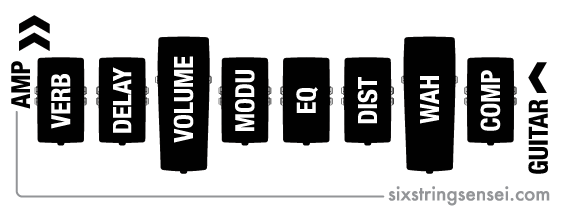
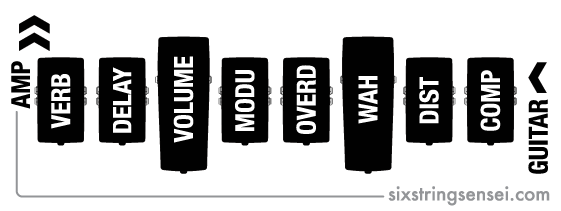
Conclusion
There are many other guitar effect pedals that can provide very complex sound arrangements. Some like different positioning on your board. I could do this all day, and probably would have to in order mention most of them. Some of these are harmonizers, octave pedals, rotary speaker pedals and combo pedals like the DigiTech Whammy – which features all kinds of octave effects and harmonizers. Some like to be near the beginning, such as octave pedals and the mentioned Whammy pedal. Others prefer the end of the chain, such as the rotary speaker pedals. But, as you can see, most of the time, the distortion and overdrive pedals sit somewhere in the middle. This means that with most pedals, their arrangement is often defined by whether they are better before or after distortion. You should use the guidelines provided in this feature as rules of thumb, but please feel free to experiment. Chances are, you’ll find something that you like and defines your sound. Have fun experimenting!
If you can recall from our earlier feature and also from the beginning of this article, there is still one last thing related to pedalboards that we need to discuss: Buffered vs true-bypass pedals. We’ll get to that shortly.
To get your guitar pedals in order, you’re still going to need a pedal board. Take a look at the Gator board below:

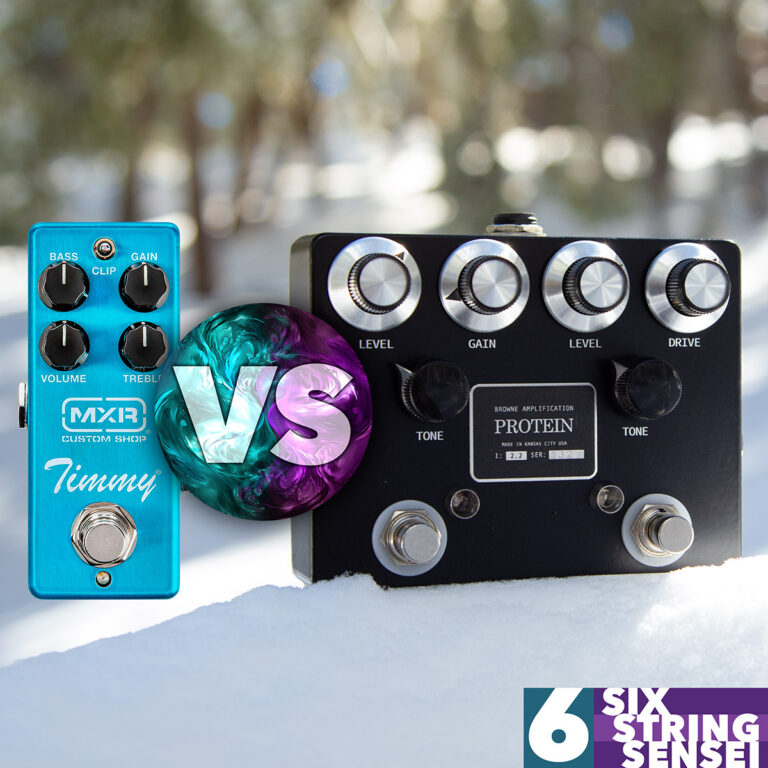
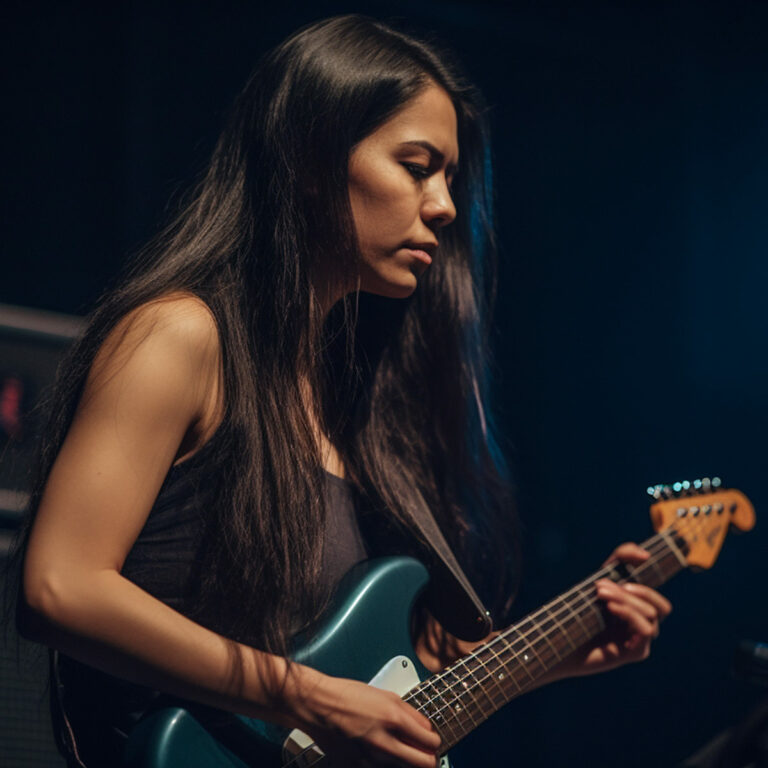
Awesome pedal board articles. New to effects pedals/boards and will use this as my guide as I set up my board. Pardon my ignorance, but I must have overlooked the position for a tuner? I have a Digitec HT6 and have been using it in first position.
@Telemanian Thanks! As far as the tuner goes, it really depends. I think I make mention of it in the article, don’t remember. But basically, if your tuner is your buffer you might want to have it first in the chain. If it’s a true bypass tuner, then it really doesn’t matter too much but it should still be near the beginning. I use a true-bypass tuner and it sits 3rd in line after my buffer and my compressor. Both of those have true-bypass switching, so I turn them both off when tuning. Done. 🙂
Could not agree more about the Egnater Rebel 30; I *LOVE* mine except for one thing:
I like the volume pedal in the effects loop (just before the echo). The Reb30’s reverb is somehow tied to the effects loop. So if you use reverb on the Reb30 and put your volume pedal in the loop, you get this very wierd bleed as you rool off the volume: the “dry” part of the signal fades, but the reverb part stays up and gets *CAVERNOUS*; sounds like you are playing in a big cave.
My solution is I bought a TC Electronics reverb pedal (never thought I could get excited about reverb, but this pedal does it!), stick that in the loop and shut the Egnater reverb off (no big loss; pretty pedestrian sounding reverb anyway). Even then, the volume pedal never fully shuts down the sound even when it is all the way off. This would be a perfect amp were it not for this IMO. I finally gave up and just put everything in front of the preamp. The only thing I use the effects loop for on the Reb is that reverb pedal (don’t really need it, but it sounds so much better than the Reb30’s ‘verb) and a BBE sonic maximiser.
The Reb 30 doesn’t seem to like humbuckers much either IMO.